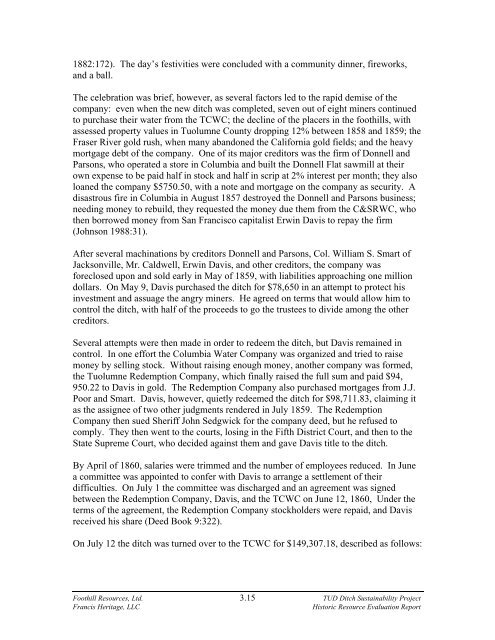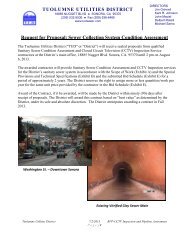Historic Resource Evaluation Project - Tuolumne Utilities District
Historic Resource Evaluation Project - Tuolumne Utilities District
Historic Resource Evaluation Project - Tuolumne Utilities District
You also want an ePaper? Increase the reach of your titles
YUMPU automatically turns print PDFs into web optimized ePapers that Google loves.
1882:172). The day’s festivities were concluded with a community dinner, fireworks,<br />
and a ball.<br />
The celebration was brief, however, as several factors led to the rapid demise of the<br />
company: even when the new ditch was completed, seven out of eight miners continued<br />
to purchase their water from the TCWC; the decline of the placers in the foothills, with<br />
assessed property values in <strong>Tuolumne</strong> County dropping 12% between 1858 and 1859; the<br />
Fraser River gold rush, when many abandoned the California gold fields; and the heavy<br />
mortgage debt of the company. One of its major creditors was the firm of Donnell and<br />
Parsons, who operated a store in Columbia and built the Donnell Flat sawmill at their<br />
own expense to be paid half in stock and half in scrip at 2% interest per month; they also<br />
loaned the company $5750.50, with a note and mortgage on the company as security. A<br />
disastrous fire in Columbia in August 1857 destroyed the Donnell and Parsons business;<br />
needing money to rebuild, they requested the money due them from the C&SRWC, who<br />
then borrowed money from San Francisco capitalist Erwin Davis to repay the firm<br />
(Johnson 1988:31).<br />
After several machinations by creditors Donnell and Parsons, Col. William S. Smart of<br />
Jacksonville, Mr. Caldwell, Erwin Davis, and other creditors, the company was<br />
foreclosed upon and sold early in May of 1859, with liabilities approaching one million<br />
dollars. On May 9, Davis purchased the ditch for $78,650 in an attempt to protect his<br />
investment and assuage the angry miners. He agreed on terms that would allow him to<br />
control the ditch, with half of the proceeds to go the trustees to divide among the other<br />
creditors.<br />
Several attempts were then made in order to redeem the ditch, but Davis remained in<br />
control. In one effort the Columbia Water Company was organized and tried to raise<br />
money by selling stock. Without raising enough money, another company was formed,<br />
the <strong>Tuolumne</strong> Redemption Company, which finally raised the full sum and paid $94,<br />
950.22 to Davis in gold. The Redemption Company also purchased mortgages from J.J.<br />
Poor and Smart. Davis, however, quietly redeemed the ditch for $98,711.83, claiming it<br />
as the assignee of two other judgments rendered in July 1859. The Redemption<br />
Company then sued Sheriff John Sedgwick for the company deed, but he refused to<br />
comply. They then went to the courts, losing in the Fifth <strong>District</strong> Court, and then to the<br />
State Supreme Court, who decided against them and gave Davis title to the ditch.<br />
By April of 1860, salaries were trimmed and the number of employees reduced. In June<br />
a committee was appointed to confer with Davis to arrange a settlement of their<br />
difficulties. On July 1 the committee was discharged and an agreement was signed<br />
between the Redemption Company, Davis, and the TCWC on June 12, 1860, Under the<br />
terms of the agreement, the Redemption Company stockholders were repaid, and Davis<br />
received his share (Deed Book 9:322).<br />
On July 12 the ditch was turned over to the TCWC for $149,307.18, described as follows:<br />
Foothill <strong>Resource</strong>s, Ltd. 3.15 TUD Ditch Sustainability <strong>Project</strong><br />
Francis Heritage, LLC<br />
<strong>Historic</strong> <strong>Resource</strong> <strong>Evaluation</strong> Report




